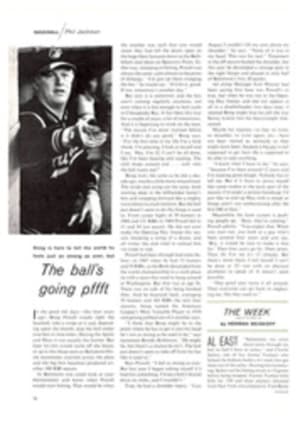
DON'T GO NEAR THE WATER? PHOOEY!
TRY 300 SIT-UPS
In the sullen, sleepy predawn, all locker rooms are much alike: the clangor of metal doors being opened and shut, the slippery coolness of varnished wood benches, the sound of ripping adhesive tape, the pungency of liniment smoothed into yesterday's knots. There are compensations for rising in the dark and tramping through dripping rain to such a place. And they are especially savored by rowers—a shared sense of superiority to softer humans still snug under blankets, and the good, cleansing, physical tiredness that follows hard exercise.
Over the years, women have been mostly reckoned among the blanketed comfortable. But there is a new sorority of crewwomen, kin to the self-punishing oarsmen of crew tradition. They have something of the same personal desperation to excel, the same compulsion to master an arcane, taxing discipline. There are now 75 women's crews and rowing associations in the U.S., with 2,000 oarswomen and a full set of regattas and league championships. Two years ago there were 37 crews. Five years ago there were 29.
Radcliffe, the national champion, went to Moscow for the European championships last year and proved itself by finishing less than three seconds slower than the winner, with only two seniors—and five freshmen—in the boat. The 'Cliffies have trained for this season like galley slaves, rowing one or two hours a day on the Charles River last fall, two or more hours this spring, and as much time in the tank as they could scrounge during the icebound months. These are serious athletes assembling at the dingy Victorian pile of Weld Boathouse come six o'clock of a December morning. Serious, but hardly somber.
"You stay on the river until the spray freezes on your face, and the megaphone freezes on the coxswain's lips," said one Radcliffe cox. "A far cry from when I started crew. It rained one day and I called up Coach John Baker and asked, "What do we do now?' "
"Supposedly, when the first ice forms, John gets in the launch and, with the untold advantage of machismo, roars around and breaks it all up," a freshman says. "When it gets worse, we put ice picks in the oarlocks. In winter, we shovel the snow off the stadium steps, and then we run them. John keeps saying, 'You needn't run the bottom steps. They're too deep to shovel anyway.' " The 25th trip up the double steps leaves the girls with the blank eyes of the cross-country man, willing away fatigue.
The calisthenics rival the rowing as hard labor. A set of exercises consists of 50 sit-ups, 10 push-ups and "the maximum number" of chin-ups. Three sets is a typical dose.
"One day we got 300 sit-ups sprung on us," a 'Cliffie says. "We were holding our stomachs for a week."
The Radcliffe rowers are conscious of the stereotypical female athlete but scarcely hung up about it. A certain Irene Winkler—6'4", 220 pounds and a star at everything—was frequently alluded to until the right number of newcomers and outsiders had asked who she was. At an appropriately public moment, just as Baker emerges from the boathouse, the crew yelled in unison "Irene!" It is generally conceded that the high point of one article about the crew was a quote from Judy Levine: "My calluses put runs in all my stockings." Radcliffe got letters from ladies all over the country containing hints on how to stop the runs.
The scene on the Charles represents progress, undoubtedly, though Connie Cervilla's grandmother, who does not approve of her rowing, asked her stiffly how this "relates to your future job." At least, she didn't ask what a future husband might think.
"My grandmother is from the old country, where men were men and women were women," Connie says.
"And never the twain shall meet," someone adds.
They have a sense of humor about rowing across the country at Long Beach, too, where getting up for a workout before the eight o'clock class is not quite so arduous, and the trip to the boathouse is only a long bike ride through the cool tonic of a California morning, before the yellow smog creeps in.
Cal State at Long Beach has problems (and advantages) that Radcliffe doesn't. Although it has the fastest improving and fastest growing crew program on the Coast, Long Beach still has the pains, financial and otherwise, of a team only two years old. Having started as an auxiliary to the men's crew, the women tend to raise money by baking cakes and raffling handmade quilts. Radcliffe, by contrast, may spend as much as $40,000 on crew this year, perhaps the largest expenditure for one sport in women's intercollegiate athletics, and wouldn't dream of serving doughnuts to anyone.
"When we first came down, the guys were mostly interested in putting the make on us," Cal State's Pam Graham says. "It took a long time to get the proper respect. But now we're tight. The men do help us, and I know they took a lot from guys on other crews."
"Girls take criticism harder, or show it more," says Coach Steve Buchan. "First few weeks, they seemed depressed. But they could see how hard the men were working, and that helped. I was impressed. A couple of girls got sick, but they came back. They got cramps, but they didn't just stop. And one day, it clicked: the boat really set up and lifted out of the water."
"I remember the day we put in together," Pam Graham says. "It started with two varsity guys trashing my lawn. I said, 'I've got a better idea.' We got the women's crew and dumped stuff on the varsity coach's lawn instead. A creative trashing. Swim buoys. Telephone poles. Highway construction markers. For Rent signs. After that, we were ready."
Then there are the peculiarly California problems. "We have trouble finding girls small and light enough to be coxswains," Buchan says. "When we do find one, she gets a job as a ski instructor or skips over to the men's program. Eight of their coxes are girls now." One of them is Ann Heuser, an interior design student. "I was kidnapped," she says. "A guy blockaded my path and said, 'How about going out for crew?' " As compensation the girls' crew gets bevies of suntanned champion swimmers and volleyball players.
The miles on the water and the legpresses aren't much fun in the short run. Nor are sit-ups, push-ups, straddle stretches, hurdle stretches, and squat jumps with 10-pound weights in each hand, but the women find a gritty satisfaction in those, too. Karen McCloskey says, "What keeps you going is thinking that nobody else in the world could possibly be working this hard."
Karen, Joan Lind and Sue Kren are good samples of the Long Beach Rowing Association, an independent organization that uses the same facility as the university.
"I can never train too hard," says Joan, U.S. national singles champion and one of the best oarswomen in the world. "My body will collapse before I can harm it."
That about describes the women of the LBRA. Sue is a marathon runner who studied classical ballet four times a week for six years. Karen is a gymnastics teacher, a guitar teacher and a bravura singer. As for Joan, she integrates pleasure and pain completely. For entertainment, she bicycles 248 miles to San Diego and back, runs 10-mile races at high altitude, backpacks and skis cross-country. She holds the alltime CSULB ergometer record, for women and men. A favorite pastime is sandbagging unsuspecting men cycling near her home.
"She'll see someone coming and slack off a little," says her father, an old ocean and channel swimmer. (Joan's uncles were distance runners.) "Then she'll go faster and faster until they see what they're up against. Never says a word. They'll follow her home. 'Man, what's goin' on here?' they ask me. 'Who is this girl?' I say deadpan, 'You mean you let a girl beat you?' "
California girls they are, luxuriating in the joys of young womanhood. They lighten their labor with women's jokes—"Go comb your armpits!"—and wear ribbons and makeup in practice and even in races.
But doesn't your mascara run, Joan? "We-ell...."
Someone answers helpfully, "Her nickname is Mudslide."
FOUR PHOTOS
FIVE PHOTOS
Radcliffe Coach John Baker (top) mildly exhorts his charges at calisthenics and Jennie Getsinger helps carry a shell against a dawnlit background of the Harvard Business School. At center and below, the Long Beach State eight on Alamitos Bay. Joan hind (bottom right) is national singles champion.

